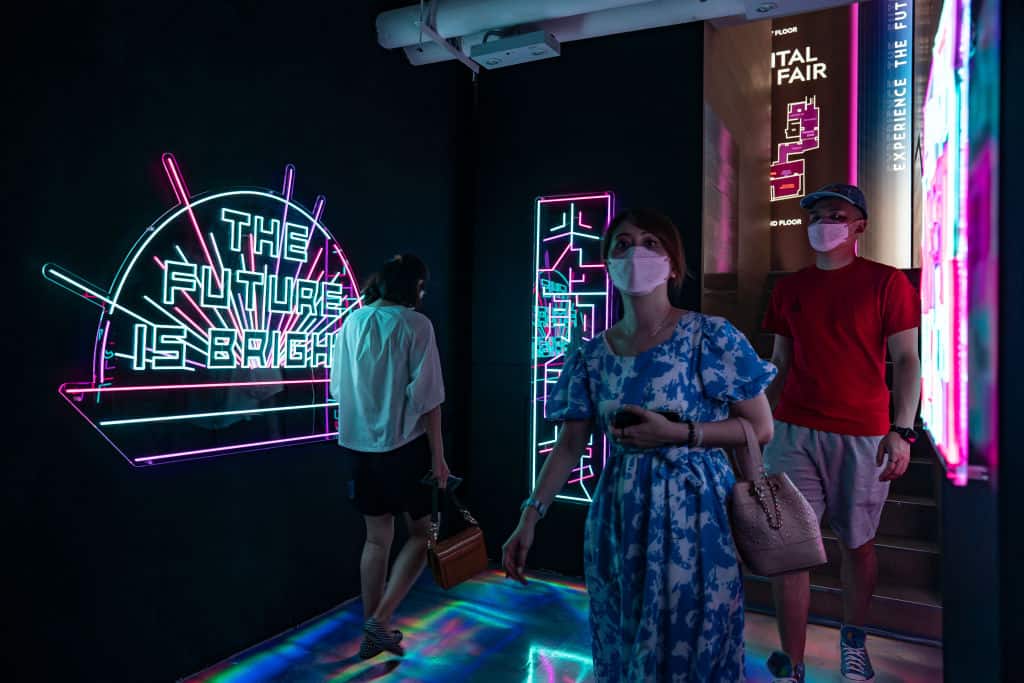In this issue
- Super Bowl: A crypto coming of age
- CryptoPunks: Property disputes
- NFT security: Hong Kong alarms
From the Editor’s Desk
Dear Reader,
Talk of crypto “prime time” — the point at which the cryptocurrency industry reaches maturity — has been making the rounds for a while, but it came to pass in the most literal sense this past Sunday at the Super Bowl.
Fans were showered with crypto-related ads no fewer than six times during the ever-popular half-time break, when a few seconds of commercial air time can command millions of dollars on the promise of reaching more than 100 million pairs of eyeballs.
Whether the crypto sector has matured or not may be a matter for debate. But the Super Bowl ad debut by industry players was indisputable evidence that they have broken through to the mainstream, at least in publicity terms, and that the connections between sports and digital assets have become too strong to ignore.
Given crypto businesses’ rapid, multimillion-dollar advance into sports, concerns over a possible bubble are only to be expected. But sports leagues’ adoption of crypto as a means of payment, among other things, suggests that a durable use case beyond trading seems to have emerged.
When it comes to non-fungible tokens (NFTs), however, the picture is more complex, and many people still struggle even to understand the NFT phenomenon. The NFT market has been on a tear and, based on Google data, it has attracted more online attention than crypto in recent months as valuations have detached from those of crypto, which have become increasingly correlated with traditional financial markets.
In a soon-to-be-released Forkast special report, we’ll explore the explosive expansion of this outgrowth of the digital asset industry. If crypto is enjoying a putative prime-time moment, will NFTs be next? It’s something Monday morning quarterbacks might want to explore post-game.
Until the next time,
Angie Lau,
Founder and Editor-in-Chief
Forkast.News
1. Game time for crypto

By the numbers: Super Bowl halftime — over 5,000% increase in Google search volume.
Super Bowl fans watching the game this past Sunday were shown crypto ads for the first time in the tournament’s history, with a multitude of companies running crypto-related commercials in a splash that gained attention from the media as well as spectators.
- During the match between the Cincinnati Bengals and the Los Angeles Rams football teams, crypto commercials by the likes of Coinbase, FTX, eToro and Crypto.com ran for more than five minutes collectively, and a BitBuy commercial ran on the Canadian broadcast of the game.
- The commercials in the Super Bowl featured such stars as basketball players LeBron James and Kyle Lowry, and comedian Larry David. Earlier this year, Matt Damon appeared in a Crypto.com commercial.
- Coinbase services crashed temporarily after the company’s commercial ran amid a sudden increase in traffic on its website.
- The Super Bowl is among the world’s most-watched sporting events, with commercial spots this year costing as much as US$7 million for 30 seconds.
Forkast.Insights | What does it mean?
SuperBowl LVI will be remembered as the first “crypto Super Bowl,” the moment that four of the world’s biggest Web 3.0 companies staked their claim to coveted coverage of the world’s most lucrative annual sporting event. Although the spectacle has been heralded as a coming of age by crypto commentators, it should be put in context.
The last time an emerging tech sector crashed the party at the Super Bowl was during the dot-com boom in the late 1990s and early 2000s. During ad breaks at the Super Bowl in 2000, 14 dot-com companies shelled out millions of dollars to tell U.S. viewers they had come of age.
In less than a year, five were gone. A combination of rising interest rates, what then-Federal Reserve Chair Alan Greenspan famously described as “irrational exuberance” among investors and the global recession brought on by the 9/11 terror attacks brought the dot-com bubble to a sudden halt. The crypto industry appears to be facing a similarly turbulent period.
Rising inflation and attendant increases in lending rates, a threat of war in Europe and spiraling commodity prices are all luring investors out of crypto and back into more familiar territory. And although most crypto companies are in much better shape than their dot-com counterparts, the next 12 months will be more of an acid test than a coronation for Web 3.0.
2. CryptoPunk clash

By the numbers: CryptoPunk — over 5,000% increase in Google search volume.
A legal battle over CryptoPunks, one of the earliest non-fungible token (NFT) collections to go live on the Ethereum blockchain, is heating up. Holders of original CryptoPunks NFTs — known as V1 — have filed a counter-Digital Millennium Copyright Act (DMCA) notice to overturn a DMCA notice filed by NFT creator Larva Labs that compelled online marketplace OpenSea to delist the V1 collection.
- OpenSea delisted the CryptoPunks V1 collection last Monday following the issuance of Larva Labs’ DMCA notice.
- The V1 series was the original collection, replaced by V2 CryptoPunks NFTs following the discovery of a smart-contract bug. Holders of V1 CryptoPunks were airdropped updated V2 versions, which became the standard, authorized NFTs in the collection.
- However, some of the V1 NFTs have been “wrapped” via a community-made smart contract and reissued as ERC-721 Ethereum tokens, a development that has the potential to lower the unit price of CryptoPunks NFTs and which prompted Larva Labs to seek the delisting of wrapped Cryptopunk V1s.
- Larva Labs had sold 210 ETH (more than US$620,000 at the time) of V1 CryptoPunks before the takedown notice was issued, and the V1 community argues that since as much as US$50 million has been spent on V1s, their holders retain at least some ownership of the assets, leading to last Friday’s counter-DMCA notice.
- Cryptopunks V2 is the world’s most traded NFT collection, with a sales volume of more than US$2 billion across 10,000 units. According to data from CryptoSlam, the wrapped V1 CryptoPunks collection has surpassed US$49 million in total volume traded since it first went on sale on Jan. 25.
Forkast.Insights | What does it mean?
Two decades ago, Harvard Law School professor Lawrence Lessig wrote a seminal essay titled “Code is Law,” which foreshadowed the tension that lay ahead between software and legal frameworks.
In the years that have elapsed since, the tech industry and lawyers have wrestled with the idea that what is written in code should in fact, be enshrined in court-enforceable law. The CryptoPunks story is the latest chapter in this ongoing saga.
On the one side is Larva Labs, which claims that because it created the CryptoPunks NFTs, it has the right to control their usage. On the other are dozens of collectors who believed that when they forked over substantial sums of money — millions of dollars, in some cases — to acquire a CryptoPunk, ownership was transferred to them.
The outcome of the case will shape the way in which digital assets are viewed in law. Professor Lessig warned that code “can embed, or displace, values from our constitutional tradition,” and went as far as to suggest that if it were not reined in, control over those values could be lost.
Although the creators of digital assets and marketplaces have written their own rules about what ownership means, it’s becoming increasingly clear that the law needs to play a more active role in determining actual outcomes.
3. Digital dangers

The Hong Kong Computer Emergency Response Team Coordination Centre (HKCERT) has named NFT- and metaverse-related risks as a top potential security threat.
- The internet security watchdog said in a statement last week that the growing popularity of cryptocurrencies was making related markets a target for criminals looking to steal sensitive user information and funds from their accounts.
- Monkey Kingdom, an NFT project founded by Hong Kong-based entrepreneurs and promoted by global celebrities, suffered an attack in December, in which cyber criminals stole some US$1.3 million worth of cryptocurrencies after hacking an administrator’s account on the project’s chat group to distribute a phishing link.
- HKCERT said that 48% of the 7,725 information security threats it handled last year were phishing scams.
- Hong Kong is experiencing an NFT boom, with top collectors identifying the territory as a potential market hub for its embrace of NFT and metaverse projects, including the construction of a so-called megacity in The Sandbox, one of the world’s most popular metaverses.
Forkast.Insights | What does it mean?
Cybersecurity has long been on Hong Kong regulators’ radar. Now, with major companies such as Animoca Brands making efforts to develop NFT and metaverse ecosystems, government agencies are taking action to monitor potential risks.
The latest expression of concern from Hong Kong’s internet security watchdog reflects its wariness of finance-related internet crime, just as NFT platforms and investors have become new prey for cyber criminals.
One of the most recent significant attacks occurred in December when Singapore-based crypto exchange AscendEX suffered a hot wallet breach that wiped out US$77 million worth of crypto and NFT assets.
To safeguard user information, NFT collectors are being advised to enable multi-factor authentication, bookmark the URLs of official NFT platforms, and set up asset transfer “whitelists” to prevent hackers from stealing their assets.
As Hong Kong’s authorities consider more and more crypto regulations, investors and the industry should not be surprised if there are more warnings — or other government action — in the works over the up-to-now unregulated NFT and metaverse space.




